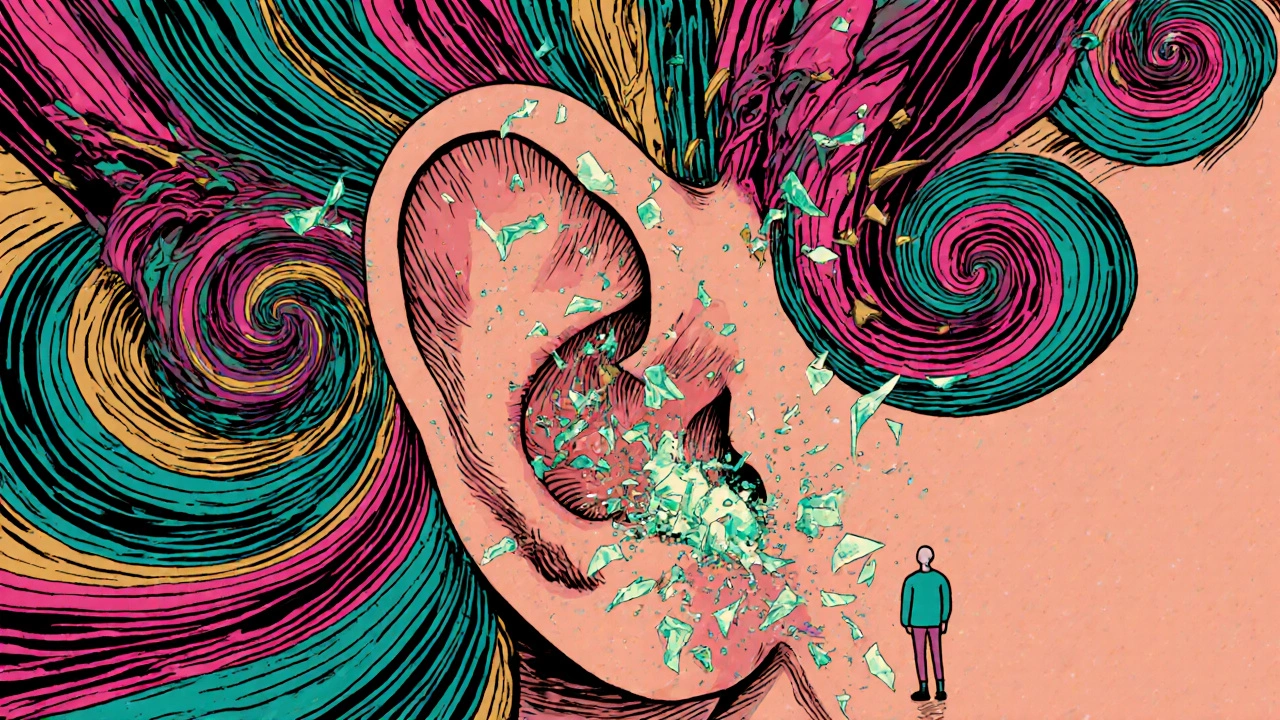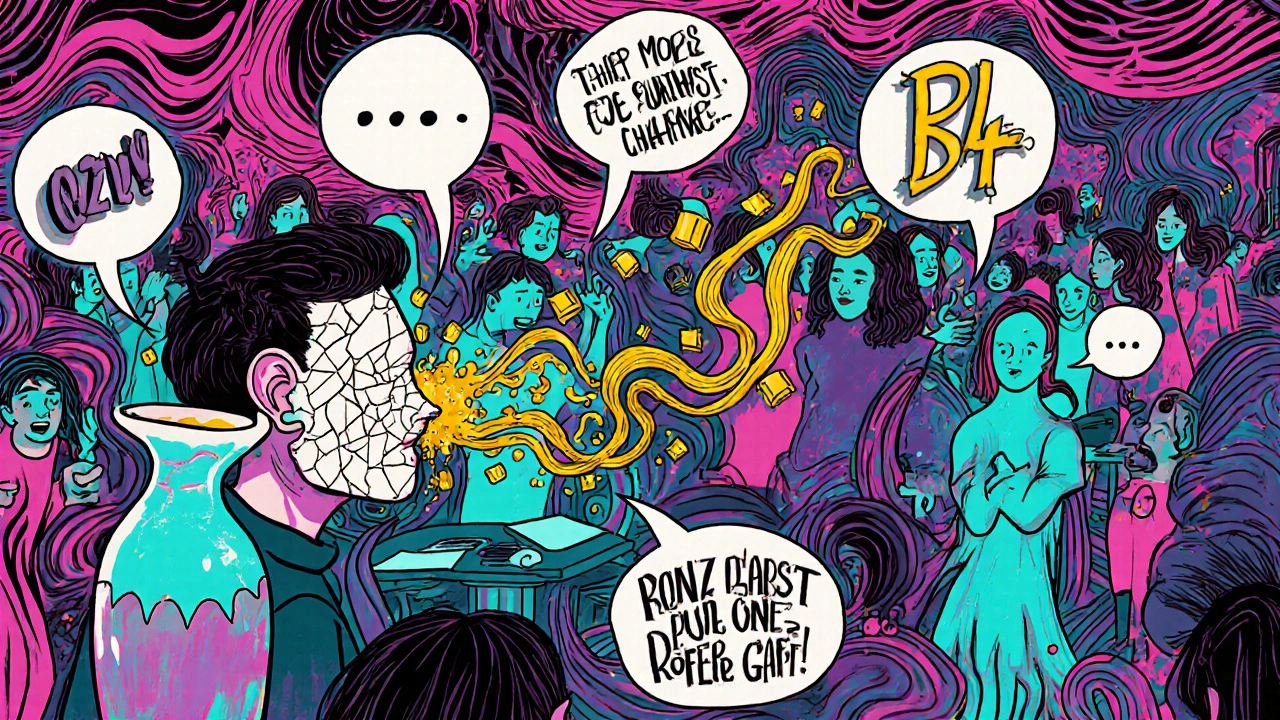Sensorineural Hearing Loss: What Causes Inner Ear Damage and Permanent Hearing Loss

What Is Sensorineural Hearing Loss?
Sensorineural hearing loss (SNHL) isn't just about turning up the volume. It's when the tiny hair cells in your inner ear or the nerve that carries sound to your brain get damaged-and once they're gone, they don't come back. This is the most common type of permanent hearing loss, making up about 90% of cases that need hearing aids. Unlike a clogged ear canal or earwax buildup, which can be cleared up, SNHL is rooted deep inside the cochlea, the spiral-shaped part of your inner ear that turns sound vibrations into electrical signals your brain understands.
How Your Inner Ear Breaks Down
Your inner ear has two types of hair cells: inner hair cells and outer hair cells. The outer ones act like amplifiers, boosting quiet sounds so the inner ones can send clear signals to your brain. When you're exposed to loud noise-like concerts, power tools, or even headphones turned up too high-those outer hair cells are the first to go. Damage starts at 85 decibels, which is about the noise level of heavy city traffic. After eight hours of that, permanent injury can begin. One loud explosion or years of daily exposure can do the same thing.
Age plays a big role too. By the time you're 65, about 25% of Americans have noticeable SNHL. By 75, that jumps to half. This isn't just "getting old"-it's the slow death of hair cells from decades of sound exposure, genetics, and reduced blood flow to the inner ear. The result? You hear people talking, but you can't make out the words, especially in noisy rooms like restaurants or family gatherings.
What It Feels Like to Live With SNHL
People with sensorineural hearing loss often say the same things:
- "I can hear you, but I can't understand what you're saying."
- "Everyone sounds like they're mumbling."
- "I hear ringing in my ears all the time."
- "Loud sounds suddenly feel too loud-like a door slamming hurts my ears."
This is called recruitment-a weird side effect where soft sounds are inaudible, but loud ones are painful. Tinnitus (ringing, buzzing, hissing) affects 80% of people with SNHL. Dizziness can happen too, if the damage spreads to the balance organs in the inner ear. It’s not just about volume-it’s about clarity, timing, and how your brain processes sound.
How Doctors Diagnose It
A simple ear check won’t cut it. You need an audiogram-a hearing test that plays tones at different pitches and volumes. In SNHL, your bone conduction scores (sound sent through your skull) are nearly the same as your air conduction scores (sound through your ear canal). That means the problem isn’t in the middle ear-it’s in the inner ear or nerve. No air-bone gap? That’s SNHL.
If you suddenly lose hearing in one ear over a few hours or days, that’s sudden sensorineural hearing loss (SSHL). It’s rare-only 5 to 20 people per 100,000 get it each year-but it’s an emergency. If you get steroid treatment within 48 to 72 hours, you have a 32% to 65% chance of recovering some hearing. Wait longer, and that chance drops fast.

Hearing Aids: The Main Solution
For most people with permanent SNHL, hearing aids are the go-to fix. Modern digital aids don’t just make everything louder-they’re programmed to boost only the frequencies you’ve lost. Most age-related SNHL hits the 2,000 to 8,000 Hz range, where consonants like "s," "th," and "f" live. A good hearing aid can amplify those sounds without blowing out your ears.
Brands like Widex Moment and Phonak Paradise get top ratings for natural sound. Costco’s Kirkland Signature models are popular for price, averaging $1,500 to $3,000 a pair. But here’s the catch: hearing aids don’t restore normal hearing. In noisy rooms, they might only improve speech understanding by 30% to 50%. Many users say they still struggle at family dinners or in crowded stores.
Cochlear Implants: When Hearing Aids Aren’t Enough
If your hearing loss is severe to profound-meaning you can’t hear sounds below 90 decibels-a cochlear implant might be your best option. It doesn’t amplify sound. Instead, it bypasses the damaged hair cells and sends electrical signals straight to the auditory nerve.
It’s surgery. General anesthesia. A few hours in the hospital. Then, you wait 3 to 4 weeks before the device is turned on. The first few weeks after activation are rough. Many people say everyday sounds-like a faucet running or a dog barking-feel painfully loud. That’s your brain relearning how to interpret signals. It takes 6 to 12 months of therapy to get good results.
But the payoff? 82% of recipients can understand speech without lip reading. That’s life-changing. One user on Reddit said, "I heard my daughter say 'I love you' for the first time in 10 years. I cried for an hour."
Why Most People Don’t Get Help
Even though 30 million American adults have SNHL, only 16% to 20% use hearing aids. Why?
- Cost: A pair can run $2,500 to $7,000. Medicare doesn’t cover them. Some insurance helps, but not always.
- Stigma: People still think hearing aids mean you’re old or weak.
- Expectations: Many expect hearing aids to fix everything. When they don’t, people give up.
- Access: Getting tested, fitted, and adjusted takes time. Not everyone lives near a good audiologist.
There’s hope on the horizon. The FDA approved over-the-counter (OTC) hearing aids in 2022, making entry-level devices cheaper and easier to buy. Brands like Eargo and Lively are targeting mild-to-moderate SNHL with apps and direct shipping. But they’re not for everyone-severe cases still need professional help.

What’s Coming Next
Scientists aren’t giving up. Stanford Medicine is testing stem cell therapies to regrow damaged hair cells. Early animal studies show promise, but human trials are still years away. Other researchers are working on gene therapies and drugs that might protect hair cells from noise damage.
Meanwhile, hearing aids are getting smarter. Oticon’s Real-X uses AI to classify environments-like a car ride or a coffee shop-and adjusts settings automatically. Cochlear’s new Nucleus 8 processor is 30% smaller and better at filtering background noise.
By 2035, experts predict 95% of people with SNHL will have access to tools that let them hear well in daily life. But until then, the best thing you can do is protect what you’ve got.
How to Protect Your Hearing
- Keep volume below 60% on headphones.
- Use earplugs at concerts, clubs, or around loud machinery.
- Take quiet breaks after noisy environments.
- Get a baseline hearing test by age 50-even if you think your hearing is fine.
- Don’t ignore sudden hearing loss. See a doctor within 72 hours.
Hearing loss doesn’t happen overnight. It’s a slow leak. But once the damage is done, you can’t refill it. The goal isn’t to wait until you can’t hear your grandkids. It’s to act before it gets that bad.
Is sensorineural hearing loss always permanent?
Most of the time, yes. Damage to the inner ear hair cells or auditory nerve can’t be reversed. But sudden sensorineural hearing loss (SSHL)-which happens over hours or days-is an exception. If treated with steroids within 48 to 72 hours, up to 65% of people recover some hearing. Delay treatment beyond two weeks, and the chance drops sharply.
Can hearing aids restore normal hearing?
No. Hearing aids amplify sound and help your brain pick up what it’s missing, but they don’t fix the damaged cells. They improve speech clarity by 30% to 50% in noisy places, but background noise will still be a challenge. Think of them as a tool to help you hear better-not a cure.
What’s the difference between conductive and sensorineural hearing loss?
Conductive hearing loss happens when sound can’t reach the inner ear-like from earwax, fluid, or a perforated eardrum. It’s often treatable with medicine or surgery. Sensorineural hearing loss is damage inside the inner ear or to the hearing nerve. It’s usually permanent and requires hearing aids or implants.
How do I know if I have sensorineural hearing loss?
If you struggle to understand speech in noisy places, hear ringing in your ears, or find that people sound like they’re mumbling, you might have SNHL. The only way to know for sure is to get a hearing test called an audiogram. It measures how well you hear different pitches and volumes-and whether the problem is in the inner ear.
Are over-the-counter hearing aids good enough for sensorineural hearing loss?
They can help if your hearing loss is mild to moderate. OTC aids are cheaper and easier to buy, but they’re not customizable. If you have severe SNHL, tinnitus, or trouble understanding speech, you need a professionally fitted hearing aid. Audiologists can program them to your exact hearing loss pattern, which OTC devices can’t do.
Can cochlear implants help with tinnitus?
Yes, for many people. Cochlear implants don’t cure tinnitus, but they often reduce it. By stimulating the auditory nerve with electrical signals, they can mask the ringing. Some users report their tinnitus drops from an 8/10 to a 3/10 after implantation. However, results vary, and it’s not guaranteed.
How long does it take to adapt to a hearing aid?
Most people need 4 to 8 weeks to adjust. At first, your own voice might sound too loud (occlusion effect), or you might hear whistling (feedback). Your brain needs time to relearn how to process sounds. Consistent daily use is key. Don’t take them off after a few days-stick with it. Audiologists usually schedule 3 to 5 follow-up visits to fine-tune settings.
Is sensorineural hearing loss genetic?
Yes, in some cases. Certain gene mutations can cause early-onset SNHL, even in children. But most adult cases are caused by noise, aging, or illness-not genetics. If multiple family members have unexplained hearing loss, especially at a young age, genetic testing may be worth considering.
What to Do Next
If you suspect you have sensorineural hearing loss, don’t wait. Book a hearing test with an audiologist. Early detection means better outcomes. Even if you’re not ready for hearing aids yet, knowing your baseline helps you track changes. Protect your ears. Reduce noise exposure. And remember-help is out there. You don’t have to struggle in silence.